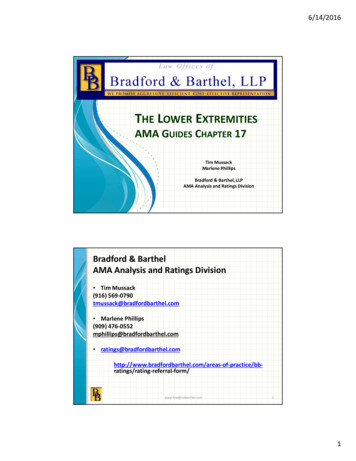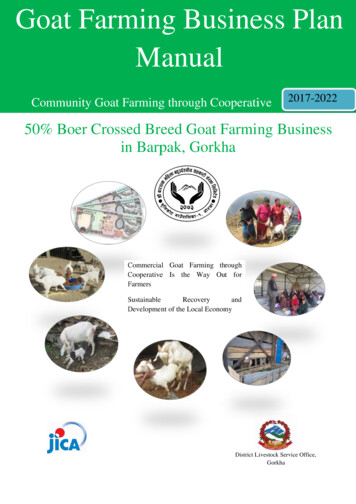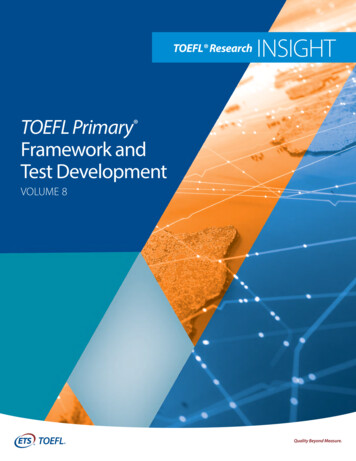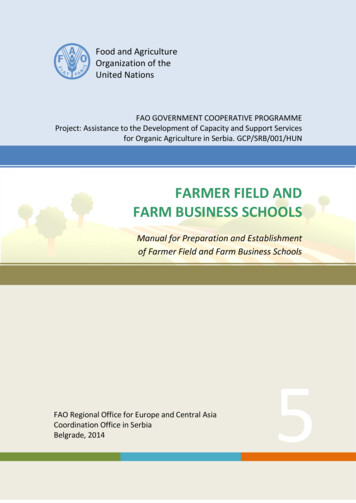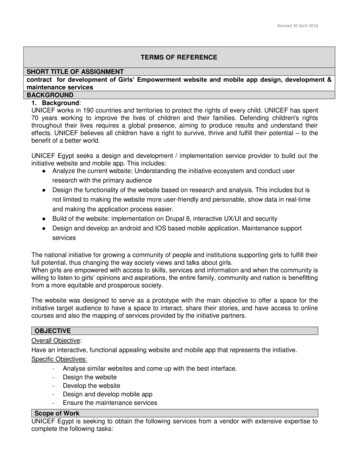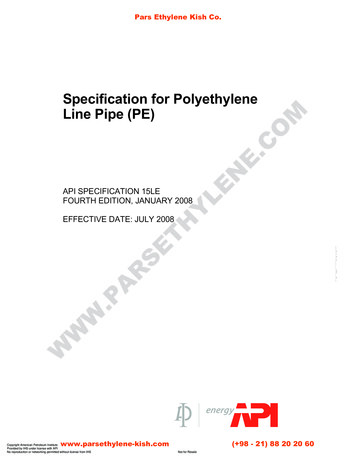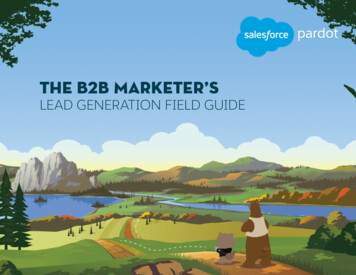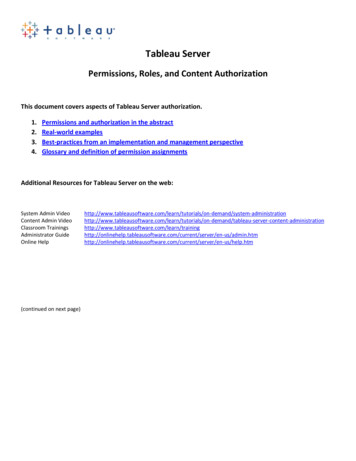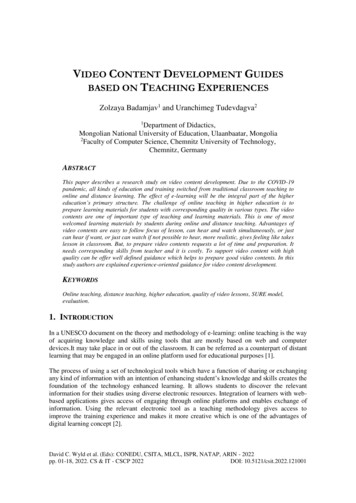
Transcription
VIDEO CONTENT DEVELOPMENT GUIDESBASED ON TEACHING EXPERIENCESZolzaya Badamjav1 and Uranchimeg Tudevdagva21Department of Didactics,Mongolian National University of Education, Ulaanbaatar, Mongolia2Faculty of Computer Science, Chemnitz University of Technology,Chemnitz, GermanyABSTRACTThis paper describes a research study on video content development. Due to the COVID-19pandemic, all kinds of education and training switched from traditional classroom teaching toonline and distance learning. The effect of e-learning will be the integral part of the highereducation’s primary structure. The challenge of online teaching in higher education is toprepare learning materials for students with corresponding quality in various types. The videocontents are one of important type of teaching and learning materials. This is one of mostwelcomed learning materials by students during online and distance teaching. Advantages ofvideo contents are easy to follow focus of lesson, can hear and watch simultaneously, or justcan hear if want, or just can watch if not possible to hear, more realistic, gives feeling like takeslesson in classroom. But, to prepare video contents requests a lot of time and preparation. Itneeds corresponding skills from teacher and it is costly. To support video content with highquality can be offer well defined guidance which helps to prepare good video contents. In thisstudy authors are explained experience-oriented guidance for video content development.KEYWORDSOnline teaching, distance teaching, higher education, quality of video lessons, SURE model,evaluation.1. INTRODUCTIONIn a UNESCO document on the theory and methodology of e-learning: online teaching is the wayof acquiring knowledge and skills using tools that are mostly based on web and computerdevices.It may take place in or out of the classroom. It can be referred as a counterpart of distantlearning that may be engaged in an online platform used for educational purposes [1].The process of using a set of technological tools which have a function of sharing or exchangingany kind of information with an intention of enhancing student’s knowledge and skills creates thefoundation of the technology enhanced learning. It allows students to discover the relevantinformation for their studies using diverse electronic resources. Integration of learners with webbased applications gives access of engaging through online platforms and enables exchange ofinformation. Using the relevant electronic tool as a teaching methodology gives access toimprove the training experience and makes it more creative which is one of the advantages ofdigital learning concept [2].David C. Wyld et al. (Eds): CONEDU, CSITA, MLCL, ISPR, NATAP, ARIN - 2022pp. 01-18, 2022. CS & IT - CSCP 2022DOI: 10.5121/csit.2022.121001
2Computer Science & Information Technology (CS & IT)E-learning involves four main components such as: a person who delivers the information orskills, a person who receives it, a technological device and, data that is shared during this process.This has become a substantial part of learning for students as it can be achieved from anydistance and time [3].The main difference of e-learning from the distance learning is the use of electronic device andinternet. In other words, it can be referred as a channel that delivers information from one point toanother numerous destinations at any time. In the beginning of introduction of digital learning,people did not fully acknowledge it because most of the part of this process includes machinerywhich made an impression that it has a deficiency in human contribution in education system [4].Because of the existence of coronavirus pandemic, a mass gathering is strongly restricted in manyareas of the globe. This has led educational institutions to make relevant changes into thestandard education system making it more digitalized. The most effective method of proceedingteaching and learning steps is e-learning because it can be achieved from anywhere and at anytime. However, there are obstacles and statistical indicators, that show the low level ofeffectiveness in gaining new information and skills [5].Adekola and Dale (2017) show in the study that E-learning involves two main elements and sixcomponents as shown in the Figure 1 [6]. In the first element of this framework, the authorreferred three counterparts related with engagement of learners with the technology. In thesecond dimension, there are three components which involve activities concerning learning andprocessing information and skills [7].Figure 1. An e-Learning framework in school education consisting of two dimensions and six componentsWhen it comes to enhancement of learning and verification of the performance, assessment is oneof the primary tools for educational institutions [8].Assessment that can be proceeded through digital environment is called e-assessment [9]. Thiscan enable various opportunities which makes it more distinguish than the traditional assessmentprocess. The digitalization of assessment can simplify the scoring process making it more timesaving. On the other hand, with the help of e-assessment, teachers can gather essential data fromthe students works [10] and can get a guaranteed answers and marks that will confirm the finalscore[11].Digitalization and automatization have brought a considerably massive changes in our thoughtsof how education system can be reformed. However, there are still a lack of deeper
Computer Science & Information Technology (CS & IT)3understandings of assessment in this regard. Hence, the majority is discussing about theassessment that comprehends genuine assessment and encourages the users [12-13].Numerous institutions are currently studying the diverse technology-based applications that usepersonal data for more reliable e-assessments[14-18].Regarding the outcomes, e-assessmentoffers more time-saving and rational options and makes the process moreinnovating[19].However, when using e-assessment, there is a small chance of avoiding fraudwhich makes it weaker. To prevent such issues, professionals from the TeSLA corporation(https://tesla-project.eu) created a tool that can identify face and voice of an individual, anyinformation that is considered as a transcript, etc [20].On of the integral part of higher education is a concept of video. It is often used both intraditional and e-learning environments as a main source for sharing an essential information. Anumber of studies have presented the statistical proofs of the effectiveness of e-learning [21-22]and other works also have shown the importance of the use of video in teaching and learningmethodology. [23-28].2. STATE OF THE ARTThe video content is one of important teaching element for e-learning. There are many differenttips around how to create video content for teaching. Vyond Studio defined 25 different hits tocreate video content[29]. These hints consist of five different dimensions: Planning, Writing,Storyboarding, Creating and Distributing. Each dimension included sub sections where explainedwhat should care during preparation of video content. Gretchen Vierstra shared learned lessonsand advantages of video lessons [30]. Gretchen Vierstra recommended to care “workingmemory” of students, that means video lessons should be short. Next hints from her is thecognitive load which should support students who cannot concentrate on different focuses.Further hits directed to care various ways to access the information for students. PatrickLowenthal with his colleagues noted that one of method to engage students during e-learning isvideo-based discussions [31].Teaching and learning during COVID-19 pandemic requested to try different engagementmethods to keep student’s motivation to study. The synchronous video-based discussions cangive opportunities to students feel in social presence together with class mates and offers chanceto illustrate and demonstrate how to solve learning problems [32]. Rahmatika in cooperation withhis colleagues published the paper about effectiveness of Youtube videos as one of useful videocontent for teaching and learning [33]. Main focus of Rahmatika is how can be fill missing gap ofteacher’s skill to work tools for video contents. Dur to the COVID-19 each single teacher must beteaching his/her course online, from distance. But not all teachers had corresponding skills towork with video tools. Usually quality of prepared video contents could not meet expected resultsof students and parents. To solve in some case this problem his team offered to use free Youtubevideos for teaching. B.D. Coller and M.J. Scott described in their paper about teaching case ofmechanical engineering courses based on video games [34].As result of their study found out that students spend twice more hours on video game withlearning material comparison with traditional learning materials. In case of Peter D. Wiens andhisco-authors study focus directed to application of video content to assessment of teachereducation [35]. Zaneldin E. et. al. used as teaching tool video contents for engineering coursesand did survey to investigates the effectiveness, benefits, and students’ satisfaction of students[36]. In total 67 students attended to survey and survey result shows that students prefer toreceive learning materials in video content and study in blended type of study.
4Computer Science & Information Technology (CS & IT)3. GUIDANCE FOR VIDEO CONTENT DEVELOPMENTWhy do we need a videocontent on this topic? How to make a video? How to reach yourstudents? What is your experience? How to evaluate the video content? will answer the question.The quality of video content for teaching depends a lot from preparation and development phases.Not all teachers have enough experiences and skills to work with video contents. But today’steaching materials for students requests to include various type of teaching tools and methods forstudent’s engagements. One of basic method for this is to use video content in teaching. Tosupport teachers who has not big experience with video content our team developed specialguidance for video content development. The guidance consists of three phases.3.1. Pre-phaseNot everything should be taught through video, so be strategic about why you're using themedium to deliver a particular topic [37]. Therefore,first and important phase of preparation ofvideo content is Pre-phase.What can be done to help you reach your goals? think about and prepare video content. Forexample, what is the student's learning style? How to choose the content of the topic? Whatelements (text, pictures, diagrams, graphs, tables, sounds, recordings, animations, illustrations)should be used to introduce the concept? etc. Didactic solutions for teaching methods need to beconsidered and planned in order to achieve and achieve the objectives of the lesson.At this stage, video content planning should be done according to the following instructions.- Research and analysis of course materialsStudy and analyse video content course materials. This may include the syllabus, pictures, tables,diagrams, audio, and additional videos used in the lesson. Course files can be placed on cloudbased devices such as google drive, one drive, and Dropbox for sharing. For example, in ourexperiment, we used Figure 2 to upload the file to Google Drive and OneDrive.Figure 2. File library located on OneDrive- Plan which elements to use. Make a storyboard
Computer Science & Information Technology (CS & IT)5Plan a storyboard before developing a video content. In other words, plan the script for thescreenplay. For example, plan the script for the screenplay. A storyboard is a series of images andsymbols that show the background image of each frame (slide for ppt), the main scene,appearance, who and where to do, what elements and information to use, and what activities takeplace. In addition to drawing the storyboard by hand on paper, you can design it using a programthat suits you. The following example shows a detailed Storyboard design for each screen (Figure3 and 4).Figure 3. An example of a storyboardFigure 4. The process of developing a storyboardIf you prefer to hand-draw your storyboard, you don’t need to draw boxes for every frame usethis free template [29].When designing a storyboard, select the type of video using the videotutorial templates in Figures 5 and 6.Hansch [38] also provide a catalogue of video production styles ‘as a method of providing acurrent overview of the field’. Their division is based on what they refer to as the productionstyle’s ‘different affordances of learning’. The production styles they define can also becombined in various forms. They list the following 18 production styles:
6Computer Science & Information Technology (CS & IT)Figure 5. Typology of Video Production Styles [38]Virtual class or green screen recordingTablet and mobile phone camerarecordingFigure 6. Typology of Video Production Styles
Computer Science & Information Technology (CS & IT)73.2. Development phaseAfter preparation of above defined elements man can start to develop video contents.- Select technology and develop materialsVideo contents can be made professionally, in the studio, or in a quiet environment using simplesoftware. Table 1 shows the possibilities of working with video product development softwareinformation. In addition, video editing software can be used online. For example:https://www.loom.com, https://www.vidyard.comTable 1. Ability to work with video processing software informationNo123456789101112ActivityWrite textUpload a photoInsert audioAudio editingUpload videoVideo editingInsert shapesInsert effectsRecord Audio Screen RecordingAdd Quiz/SurveySave in video formatPowerPoint MoviemakerCamtasia iSpringsuite SnagIt AdobePremier 3.3. Evaluation phaseReady video contents should go through local evaluation. For evaluation of prepared videocontents team applied structure-oriented evaluation SURE model [39].This method is called SURE (StrUcture oRiented Evaluation) and is designed to contribute to thespace for evaluating e-learning with a science-based methodology (Figure 7). The model was firstdiscussed at its first meeting in 2011 to assess e-learning in a multi-dimensional space with theparticipation of all stakeholders. One of the features of this methodology was that the goals of theevaluation were defined by the main and sub-goals, and then these goals were expressed in alogical scheme [40-42].Figure 7. Evaluation and e-learning framework [42]
8Computer Science & Information Technology (CS & IT)Step 1. Definition of key goalsThe main aim of the first step of the SURE model is to define key goals of evaluation process.All defined key goals should reach its target and the general evaluation result will be successfulor bigger than zero only if all key goals reached their target successfully. If one of the key goalsis failed, then the e-learning process will be evaluated as failed. The main goals of the evaluation: Planning (B1)Technologists (B2)Contents (B3)Performance (B4) dependence, implementationconsists of goals(Figure8).Figure 8. Goal structures of video contentStep 2. Definition of sub goalsDetermining the steps that need to be taken to achieve the main goals is the step that defines thesub-goals.In order for Planning (B1) to be successful, the following sub-goals must be met. These include: Course content planning (A11)Lesson material planning (A12)Lesson methodological planning (A13)Screen design (A14)Course file compilation (A15)The following sub-goals must be met in order for Technology (B2) to achieve its primaryobjectives. These include: Environment (A21)Video (A22)Speaker's voice (A23)Accompanying sound (A24)Content (B3) in order to achieve the main goal, the following sub-goals must be met. Theseinclude: Topic content (A31)Object (A32)Record type (A33)Information Ethics (A34)Spelling and grammar (A35)Didactic solution (A36)Performance (B4) in order to achieve the main goal, the following sub-goalsmust be met. Theseinclude:
Computer Science & Information Technology (CS & IT) 9Video content Troubleshooting (A41)Video content distribution (A42)Figure 9 shows the structure of the sub-goals, which consists of five, four, six, and two subobjectives.Figure 9. Evaluation sub-goalsstructureStep 3. Confirmation of evaluation goalstructuresWe defined four goals as key goals. These key goals should reach its target all together. This isessential important for goal structure definition. First key goal consists of five, second key goalconsists of four, third key goal consists of six and fourth key goal consists of two sub goals.Difference of sub goals from key goal is if just one of sub goal is evaluated as successful thecorresponding key goal will be receiving successful evaluation score.The purpose of this evaluation was presented and approved by the student who developed thevideo content, the student who was the teacher, the student who developed the SUREmethodology, and the leaders of the video content development teams.Step 4. The checklist of evaluationThe checklist of evaluation should create based on defined goal structures of the SURE model.Basically, sub goal definition can become fundamental for checklist questions. In Table 2 showexample questions which developed for key goals Planning and Technology.
10Computer Science & Information Technology (CS & IT)Table 2. Development of questions related to the main goalsof Planning (B1) and Technology (B2)Corresponding pointsEvaluation indicators1Planning (B1)2345Technology StronglydisagreeThe content of the lesson isdesigned in a simple, clear andinteresting wayThe course materials are designedto fully express the content, andthe type and format appropriate tothe video is selected.The teaching methodology isdesigned to be motivating andengagingEach frame was clearly mapped,each element was formulated indetail, and explanatory notes weremadeThe file directory and resourcesused in the lesson are wellestablishedThe video should be played on anyplayer and on devices such as amobile phone or tabletThe video is well timed,uninterrupted, non-vibrating, andrecorded normally.(Not more than6 minutes)Theteacher'sspeechandexplanations are recorded clearlyand audiblyAccompanying sounds and audiosare written in accordance with thecontentThe question is developed in the form of a final definition, and the data are collected bymeasuring the extent to which the evaluator agrees with the definition. Here:-Strongly agree - 5 pointAgree - 4pointDon’t know - 3pointDisagree - 2pointStrongly disagree - 1pointStep 5. Acceptance of checklistThe checklist should control by all involved groups in evaluation process and only checked andconfirmed checklist should be apply for data collection. Clear formulation of questions is onlyone aspect of checklist. Each member of the evaluation team has to check that beforeconfirmation and, if necessary, appearance and design of checklist has to be improved.
Computer Science & Information Technology (CS & IT)11Step 6. Data collectionThere are several techniques for data collection: surveys and questionnaire, tests and assessments,interviews, focus groups, action plans, case studies, and performance records [43]. Evaluationteam can use any of these techniques. Most attractive and fashion technique is online checklist.Data collection via online checklist increases quality of collected data avoiding human errorduring paper-based data collection.In this study, we used the Google form free online survey form (Figure 10).Figure 10. Questionnaire example in Google formStep 7. Data processingAnother advantage of the SURE method is the online data processing calculator for the method[44].The online calculation program starts with the main window called SURE model evaluation. Enter checklist data - enter the collected data in the appropriate formatIn the Color scale type section, select from 4 color options to adjust the color of the resulttable.Checklist data display format –collected data can be show in result table in three differentviewIn the Evaluation table - select the format in which the SURE evaluation results will bedisplayedFigure 11. The upper part of the data calculation program
12Computer Science & Information Technology (CS & IT)Step 8. The evaluation reportsFigure 12. The evaluation reports of video contentThe SURE model delivered four different scores after data processing. First one is general evaluation score.o𝑄𝑒 (𝐶) 0.87The result of SURE data processing shows general evaluation score as 0.87. If transfer itto percent (maximum is 100%) the evaluation result can be explained as the 87%succeeded by responses data. Second result is scores for key goals.oooo𝑄𝑒 (𝐵1 ) 0.82;𝑄𝑒 (𝐵2 ) 0.93;𝑄𝑒 (𝐵3 ) 0.8;𝑄𝑒 (𝐵4 ) 0.9.
Computer Science & Information Technology (CS & IT)13These scores show how good reached targets for key goals. Best score received the fourthkey goal and worst one is third key goal. But all scores are reached its target as over80%. Third result is scores for sub goals.ooooooooooooooooo𝑄 (𝐴11 ) 0.73;𝑄 (𝐴12 ) 0.73;𝑄 (𝐴13 ) 0.81;𝑄 (𝐴14 ) 0.69;𝑄 (𝐴15 ) 0.73;𝑄 (𝐴21 ) 0.88;𝑄 (𝐴22 ) 0.8;𝑄 (𝐴23 ) 0.78;𝑄 (𝐴24 ) 0.73;𝑄 (𝐴31 ) 0.84;𝑄 (𝐴32 ) 0.83;𝑄 (𝐴33 ) 0.88;𝑄 (𝐴34 ) 0.69;𝑄 (𝐴35 ) 0.8;𝑄 (𝐴36 ) 0.69;𝑄 (𝐴41 ) 0.86;𝑄 (𝐴42 ) 0.84.These scores are show success of sub goals. Best scores received the sub goals 𝐴21 and𝐴33 . Worst scores are linked to sub goals 𝐴34 and 𝐴36 . Fourth result is evaluation score of each participant in the evaluation process.oooooooooooooooo𝑘1 0.67;𝑘2 0.87;𝑘3 0.74;𝑘4 1;𝑘5 1;𝑘6 0.79;𝑘7 0.93;𝑘8 0.78;𝑘9 0.93;𝑘10 0.91;𝑘11 0.84;𝑘12 0.9;𝑘13 0.64;𝑘14 1;𝑘15 1;𝑘16 1;These scores are show evaluation result of each student. In total 16 students are taking part of thisevaluation process. 5 of 16 students evaluated of video content with maximum score 1. Twostudents evaluated with most worst scores: 0.64 and 0.67.
14Computer Science & Information Technology (CS & IT)4. APPLICATION EXAMPLEThe offering guidance was applied to teaching process. Students (in future teachers) preparedvideo contents following giving guidance.The 3rd semesterstudents of the Informatics class weredivided into 5 groups and made video content on a specific topic.Table 3. Video content topicsGroup number and video content topicsGroup 1: Data, information and knowledgeGroup2: MultimediaGroup 3: DatabaseGroup 4: Turtle GraphGroup 5: Types of information systemsTeams created video content on selected topics. The purpose of the topic was defined accordingto the instructions and a storyboard was created (Figure 13).Figure 13.Introducing the storyboardThe video content was selected from the Typology of Video Production Styles(Figure 5).Thedeveloped video content was presented to other teams during the lesson and evaluated on its ownand independently (Figure 13).The video content of the teams is shown below.Group 1: Data, information and knowledgeGroup2: MultimediaGroup 3: Database
Computer Science & Information Technology (CS & IT)15Group 4: Turtle GraphGroup 5: Types of information systems5. CONCLUSIONSDuring a pandemic, there is a need for a blendedlearning activities. Therefore, the study of videocontent development methodology is considered to be timely. This paper suggests that videocontent can be developed according to guidelines in the preparation, development, and evaluationphases, and that the video content can be evaluated using the SURE assessment model.Students work with small groups to develop video content, introduce it to each other, and shareexperiences. The video content was evaluated according to a checklist developed by the teacher,and the results were analyzed using the SURE assessment model. The assessment is done twice.It can improve the quality of video content and create good video content.Using this guidance, teachers can gain sufficient experience and skills to work with videocontent.REFERENCES[1][2][3]UNESCO, I. (2013) Glossary of Curriculum Terminology. Geneva: (UNESCO-IBE).Seel, N. M. (2012) Encyclopedia of the sciences of learning. London-New York: Springer.Selviandro, N., & Hasibuan, Z. A. (2013) Cloud-Based E-Learning: A Proposed Model and Benefitsby Using E-Learning Based on Cloud Computing for Educational Institution. In: Mustofa K.,Neuhold E.J., Tjoa A.M., Weippl E., You I. (eds) Information and Communication Technology. ICTEurAsia 2013. Lecture Notes in Computer Science, vol 7804. Springer. Berlin, 6818-9 20
Computer Science & Information Technology (CS & IT)The economic times. (2022) Retrieved from earningLizcano, D., Lara, J. A., & White, B. e. (2020) Blockchain-based approach to create a model of trustin open and ubiquitous higher education. Journal of Computing in Higher Education, 32, -09209-yAdekola, J., & Dale, V. (2019) Development of an institutional framework to guide transitions intoenhanced blended learning in higher education. Research in Learning Technology, 25, 16.doi:https://doi.org/10.25304/rlt.v25.1973Kong, S. C. (2021) Delivery and evaluation of an e-Learning framework through computer-aidedanalysis of learners’ reflection text in a teacher development course. RPTEL 16, lements, M. D., & Cord, B. A. (2013) Assessment guiding learning: developing graduate qualitiesin an experiential learning programme. Assessment and Evaluation in Higher Education, 38(1),pp114–124.NC. (2010) Transitioning to Online Assessment in North Carolina. The North Carolina State Boardof Education, NC.Ripley, M. (2009) Transformational Computer-based Testing.In: Scheuermann, F., Björnsson, J.(eds.), Reykjavik, Iceland.Conole, G., & Warburton, B. (2011) A review of computer-assisted assessment.ALT-J 13(1), pp17–31.Mora, M. C., Sancho-Bru, J. L., Iserte, J. L., & Sánchez, F. T. (2012) An e-assessment approach forevaluation in engineering overcrowded groups. Computers and Education, 59, pp732–740.Mueller, J. (2014) Authentic assessment toolbox. North Central College, Naperville. Retrieved ydoit.htmGaytan, J., & McEwen, B. C. (2007) “Efective online instructional and .1080/08923640701341653.Jones, D. R. (2011) Academic dishonesty: Are more students cheating? Business CommunicationQuarterly, 74(2), pp141–150. doi:https://doi. org/10.1177/1080569911404059.McCann, A. L. (2010) Factors afecting the adoption of an e-assessment system. Assessment &Evaluation in Higher Education, 35(7), pp799–818. ra, I., Guerrero-Roldan, A. E., & Rodríguez, M. E. (2017) Assuring authorship andauthentication across the e-assessment process. In Proceedings of the Technology EnhancedAssessment, TEA 2016 (pp. 86–92). doi:https://doi.org/10.1007/978- 3-3Underwood, J., & Szabo, A. (2003) Academic ofences and e-learning: Individual propensities 4(4),467–478.doi:https://doi.org/10.1111/1467- 8535.00343.Jisc. (1993) Joint information systems committee. Retrieved from https://www.jisc.ac.ukMuravyeva, E., Janssen, J., Dirkx, K., & Specht, M. (2019) Students’ attitudes towards personal datasharing in the context of e-assessment: Informed consent or privacy paradox? In Proceedings of the2018 International Technology Enhanced Assessment Conference, TEA 2018, (pp. 16–26).Amsterdam, The Netherlands.Means B, T. Y. (2010) Evaluation of Evidence-Based Practices in Online Learning: Meta-Analysisand Review of Online Learning Studies. Washington, DC: US Department of Education.Schmid RF, B. R. (2014) The effects of technology use in postsecondary education: a meta-analysisof classroom applications. Comput Educ.Allen W, A. S. (2012) Effects of video podcasting on psychomotor and cognitive performance,attitudes and study behavior of student physical therapists. Innov Educ Teach Int.Kay R, H. (2012) Exploring the use of video podcasts in education: a comprehensive review of theliterature. Comput Human Behav.Lloyd S, A. R. (2012) Screencast tutorials enhance student learning of statistics. Teach Psychol.Rackaway C. (2012) Video killed the textbook star? Use of multimedia supplements to enhancestudent learning. J Pol Sci Educ.Hsin W, J. C. (2013) Short videos improve student learning in online education. J Comput Sci Coll.Stockwell B, R. S. (2015) Blended learning improves science education. Cell.Vyond Team, (2021), “How to Make an Instructional Video: 25 Essential Tips”, Online create-engaging-instructional-videos/
Computer Science & Information Technology (CS & IT)17[30] Gretchen Vierstra, (2022) “Teacher videos: 5 reasons why making your own videos can help withdistance learning”, Online available: ith-distance[31] Patrick Lowenthal, Richard West, Leanna Archambault and Jered Borup, (2020) “Engaging StudentsThrough Asynchronous Video-Based Discussions in Online Courses”, Online discussions-in-online-courses[32] Peter Fadde and Phu Vu, (2014) "Blended Online Learning: Benefits, Challenges, andMisconceptions," in Online Learning: Common Misconceptions, Benefits and Challenges, eds.Patrick R. Lowenthal, Cindy Yor
video contents are easy to follow focus of lesson, can hear and watch simultaneously, or just can hear if want, or just can watch if not possible to hear, more realistic, gives feeling like takes lesson in classroom. But, to prepare video contents requests a lot of time and preparation. It needs corresponding skills from teacher and it is costly.
